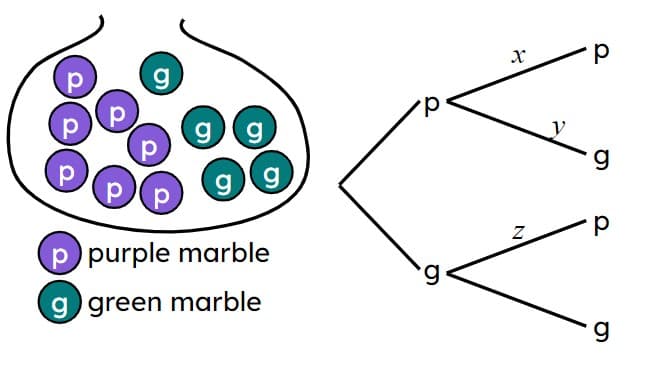

Conditional probability in a tree diagram
I can calculate a conditional probability from a tree diagram.


Conditional probability in a tree diagram
I can calculate a conditional probability from a tree diagram.
These resources will be removed by end of Summer Term 2025.
Switch to our new teaching resources now - designed by teachers and leading subject experts, and tested in classrooms.
These resources were created for remote use during the pandemic and are not designed for classroom teaching.
Lesson details
Key learning points
- A tree diagram can be used to calculate conditional probabilities
- A tree diagram can be used to calculate conditional probabilities involving sets of events
- Tree diagrams allow us to identify which events are mutually exclusive
- Tree diagrams can be used to identify which events are independent
Keywords
Probability - The probability that an event will occur is the proportion of times the event is expected to happen in a suitably large experiment.
Probability tree - Each branch of a probability tree shows a possible outcome from an event or from a stage of a trial, along with the probability of that outcome happening.
Independent events - Event A is independent of event B if the probability of event A occurring is not affected by whether or not event B occurs.
Mutually exclusive - Mutually exclusive events have no outcomes in common.
Common misconception
When pupils construct probability trees for scenarios where two marbles are removed from a bag, they may mistakenly subtract 2 from the denominators of the probabilities instead of 1.
Even though two marbles are removed from the bag at once, you can think of it at choosing one marble and then immediately choosing a second marble. At the end of the process, two marbles have been removed.
To help you plan your year 11 maths lesson on: Conditional probability in a tree diagram, download all teaching resources for free and adapt to suit your pupils' needs...
To help you plan your year 11 maths lesson on: Conditional probability in a tree diagram, download all teaching resources for free and adapt to suit your pupils' needs.
The starter quiz will activate and check your pupils' prior knowledge, with versions available both with and without answers in PDF format.
We use learning cycles to break down learning into key concepts or ideas linked to the learning outcome. Each learning cycle features explanations with checks for understanding and practice tasks with feedback. All of this is found in our slide decks, ready for you to download and edit. The practice tasks are also available as printable worksheets and some lessons have additional materials with extra material you might need for teaching the lesson.
The assessment exit quiz will test your pupils' understanding of the key learning points.
Our video is a tool for planning, showing how other teachers might teach the lesson, offering helpful tips, modelled explanations and inspiration for your own delivery in the classroom. Plus, you can set it as homework or revision for pupils and keep their learning on track by sharing an online pupil version of this lesson.
Explore more key stage 4 maths lessons from the Conditional probability unit, dive into the full secondary maths curriculum, or learn more about lesson planning.

Licence
Starter quiz
6 Questions





Exit quiz
6 Questions

$$x$$ -
0.2
$$y$$ -
0.1
$$z$$ -
0.7





